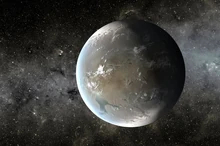
Kepler-62f (previously known as KOI-701.04) is a Super-Earth exoplanet located in the Kepler-62 system. It is the fifth and final planet of the system and orbits inside Kepler-62's habitable zone. Along with Kepler-186f and Kepler-442b, Kepler-62f is one of the most Earth-like planets to date.
Kepler-62f is the third-largest planet of the Kepler-62 system, with 140% the size of Earth. This world along with the sister planet Kepler-62e, may be a planet mostly dominated in water. What Kepler-62f does not share with its sibling is a potentially thick atmosphere mostly made of carbon dioxide.
Physical Characteristics[]
Kepler-62f is the "middle planet" of the Kepler-62 system. At 1.4 times the size of Earth, it has a diameter of roughly 17,838.8 kilometers (11,130 miles). However, like most transiting exoplanets, there is not a solid value for the mass of Kepler-62f. Radial velocity measurements have given Kepler-62e and Kepler-62f upper mass limits of about 35 Earth masses. Since these values are way too high for terrestrial planets, the PHL has estimated a more likely mass of 2.57 times that of Earth.
Using the PHL's estimated mass for Kepler-62f, it is possible to calculate other values about the planet. Kepler-62f may have about 1.3 times Earth's gravity and a density of 5 g/cm cubed or less. With a mass of 2.57 Earths, this planet would have an escape velocity of about 15.176 kilometers per second.
Kepler-62f is likely to be a planet mostly covered in water, possibly with little or no land. The ice caps on this planet should be significantly larger than those on Earth. As for the rest of the planet;s composition, Kepler-62f is likely to have an Earth-like interior; an iron core taking up about 25% the planet's volume, and the rest being the silicate mantle and crust.
Climate and Atmosphere[]
With a semi-major axis of 0.718 AU, Kepler-62f would have a temperature of about 243 Kelvin (-30* Celsius or -22* Fahrenheit). However, a thick atmosphere is possible due to the large size of the planet and higher levels of geologic activity. A 2016 study by at team of researches at UCLA showed that Kepler-62f can be habitable with a wide variety of atmospheric conditions, with different pressures and amounts of Carbon Dioxide.
The team found out that atmospheres from 0.9 to 12 times as thick as Earth's atmosphere can raise the global temperature of Kepler-62f to at least 280 kelvin, where water would be liquid. However, there also had to be specific amounts of Carbon Dioxide inside the atmosphere to help heat up the planet. Depending on the atmospheric pressure on Kepler-62f, it would have 1 to 2,500 times the level of CO2 that Earth currently has.
If these simulations turn out to be mostly true, then it is likely for Kepler-62f to has a moderately thick atmosphere made mostly of CO2. However, there could be trace gases like nitrogen, oxygen, methane, argon, sulfur, and carbon monoxide mixed in. The thick atmosphere and wide oceans of Kepler-62f would guarantee more hurricanes than what normally forms on Earth.
Habitability[]
Kepler-62f may be habitable with or without high levels of CO2. If the planet's temperature is around the predicted 243 kelvin, then a small band of water could exist around the equator and allow life to develop. But with an atmosphere that can warm up most of the planet, Kepler-62f may have many more life-friendly locations across its surface.
Unlike other Potentially Habitable Exoplanets like Kepler-186f, Kepler-62f is far enough away from its star to avoid being rendered uninhabitable by large coronal mass ejections from its star. It is also far enough away to not be tidally locked; Kepler-62f may have a rotation period similar or slightly longer than that of Earth.
In 2015, Kepler-62f and two other Kepler planets (186f and 442b) were shown to likely be the best candidates for being potentially habitable. The star Kepler-62 is a K-Type star that not only can live to up to 20-30 billion years, but also lacks the furious stellar activity that M and G dwarfs can produce. Kepler-62f shares these host star traits with Kepler-442b.
Possible Moon[]
A 2014 study on the long-term tidal effects on potentially habitable exoplanets shows that Kepler-62f could possibly have a moon. If Kepler-62f has the inferred mass of 2.57 times that of Earth, then its Hills Sphere would be about 1,039,661.25 miles (1,666,335.05 kilometers). That is large enough for at least 1 major moon and a few captured asteroids. Kepler-62f's relatively large semi-major axis makes sure that any natural satellites would have stable and possibly permanent orbits.
In 2016, a study showed that many terrestrial planets, such as those like Kepler-62f, could have experienced a collision like the one that formed our moon. This raises the chances for Kepler-62f to have at least one natural satellite currently orbiting it.